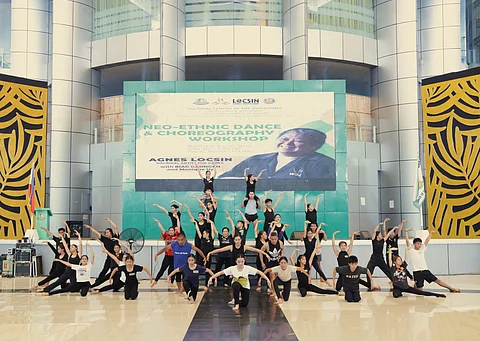
- NEWS
- the EDIT
- COMMENTARY
- BUSINESS
- LIFE
- SHOW
- ACTION
- GLOBAL GOALS
- SNAPS
- DYARYO TIRADA
- MORE

“Sana (Hopefully) there will be some who will develop their own Filipino movements using our history and our culture,” said Agnes Locsin, National Artist for Dance, hoping that her so-called Neo-Ethnic style of dance will inspire dancers in their artistic pursuits.
Recently, Locsin worked with the Cultural Center of the Philippines (CCP) Arts Education Department for the CCP Neo-Ethnic Education Program, which aims to teach selected participants that dance style. The program includes workshops on modern and Neo-Ethnic dance techniques and choreography, lectures on the histories of Philippine and Neo-Ethnic dances, and repertory classes, culminating in special showcases.
After conducting a series of workshops in different venues, Locsin was impressed by the enthusiastic responses of the participants and how they participated in different activities such as lecture-demonstrations and intense workshops. She felt the need to do something after concluding most of the workshops, asking attendees on how to gain an in-depth understanding of Neo-Ethnic dance.
Despite acknowledging that it requires a significant amount of time and effort to make such an initiative a reality, she stated that giving Neo-Ethnic dance lessons is one of the significant efforts that needs to be initiated.
“So, the main question was ‘Where do we go from here?’ because the participants were made aware, but they know so little and they have much to learn. Maybe I should make a syllabus and work with the Department of Education, the National Commission for Culture and the Arts and the CCP dahil mahalagang mabigyan ng klase iyong mga teacher na nagtuturo ng arts sa mga eskwelahan (Because it is important to provide classes to teachers who teach the arts in schools),” commented the National Artist.
Since February, the National Artist and CCP have been to different regions to conduct workshops including Malolos in Bulacan from 7 to 11 February, with more than 70 participants mentored by dance professionals Kare Adea and Biag Gaongen. Over 160 people attended the workshop at the University of Southeastern Philippines in Davao del Sur, which was made possible through the generous support from Biag Gaongen, Samantha Martin, and Monique Uy. Locsin and CCP headed to Ateneo de Davao University in Davao City for another productive workshop. With dance teachers Uy and Gaongen, a three-day educational session was held in Tagum City, Davao del Norte, drawing attendees from Cagayan de Oro City, the Misamis provinces, and Marawi City in Lanao del Sur. For the last leg of the workshop, the National Artist visited the Philippine High School for the Arts on from 26 to 30 April with various dance teachers.
Birth of the Neo-Ethnic style
Locsin obtained her Bachelor’s degree in English from Ateneo de Davao in 1979. It was while pursuing her Master’s degree at Ohio State University that she developed her Neo-Ethnic style of dance. Locsin explored several Filipino dance moves, being amazed at the diversity.
“Years later, I was in Amsterdam, [and] I was asked to choreograph. Naisip ko anong gagawin ko kasi (I was thinking what will I be doing because) I was in Europe at nandoon ang (and there are) ballet at (and) modern dances. So, I thought mag-Filipino nga ako para maiba, para makita ang kaibahan ng kultura natin (to do Filipino style to be different, to show how different our culture is). That’s when I choreographed my first Neo-Ethnic dance, ‘Igorot,’” she related.
During her time in her home city, Davao, Locsin was assigned to the Filipino section at the school and company her mother established, the Locsin Dance Workshop, where she primarily taught Filipino dances that she had learned. That was why she was no longer surprised to see herself doing Filipino dances after joining Ballet Philippines.
The term, “Neo-Ethnic” came about when Locsin was asked to characterize “Igorot” that she was restaging for Ballet Philippines. She believed that Joey Ayala’s term, “Neo-Ethnic,” was the best way to describe her dance. She sought permission to use it, and the rest is history. She also used the term “Urban Natives” in the 2000s, which was also originally from Ayala, referring to the use of the Neo-Ethnic in urban settings.
Being National Artist
When asked what has changed after she was proclaimed National Artist, Locsin said, “Mas naging busy. Nadagdagan ang gagawin bukod sa karaniwan kong ginagawa dito sa Davao. Naalala na kasi ako ng CCP at NCCA (I became busier. I am doing more work aside from what I usually do here in Davao because CCP and NCCA remember me).”
Locsin is the sixth National Artist in the field of dance. The others are Francisca Reyes Aquino, declared in 1973, Leonor Orosa Goquingco in 1976, Lucrecia Reyes-Urtula in 1988, Ramon Obusan in 2006, and Alice Reyes in 2014. She is the sixth National Artist who is born, resided in or whose family hailed from Mindanao after visual artist Victorio Edades, declared in 1976, dance artist Goquingco, visual artist Ang Kiukok in 2001, visual artist Abdulmari Asia Imao in 2006, and historian and writer Resil Mojares in 2018.
